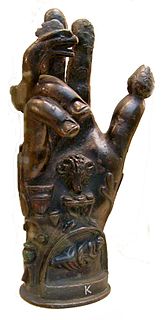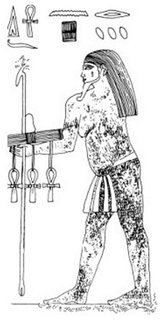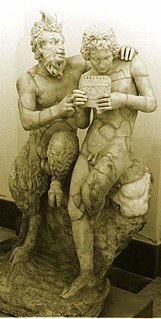Related Research Articles

In ancient Greek religion and mythology, Demeter is the Olympian goddess of the harvest and agriculture, presiding over grains and the fertility of the earth. She is also called Deo (Δηώ). In Greek tradition, Demeter is the second child of the Titans Rhea and Cronus, and sister to Hestia, Hera, Hades, Poseidon and Zeus. Like her other siblings but Zeus, she was swallowed by her father as an infant, and rescued by Zeus.

In ancient Roman religion, Ceres was a goddess of agriculture, grain crops, fertility and motherly relationships. She was originally the central deity in Rome's so-called plebeian or Aventine Triad, then was paired with her daughter Proserpina in what Romans described as "the Greek rites of Ceres". Her seven-day April festival of Cerealia included the popular Ludi Ceriales. She was also honoured in the May lustratio of the fields at the Ambarvalia festival, at harvest-time, and during Roman marriages and funeral rites. She is usually depicted as a mature woman.

Tyche was the presiding tutelary deity who governed the fortune and prosperity of a city, its destiny. In Classical Greek mythology, she is the daughter of Aphrodite and Zeus or Hermes, and at this time served to bring positive messages to people, relating to external events outside their control.

In ancient Roman religion, Abundantia also called Abundita or Copia was a divine personification of abundance and prosperity. The name Abundantia means plenty or riches. This name is fitting as Abundantia was a goddess of abundance, money-flow, prosperity, fortune, valuables, and success. She would help protect your savings and investments. Abundantia would even assist someone with major purchases. She was among the embodiments of virtues in religious propaganda that cast the emperor as the ensurer of "Golden Age" conditions. Abundantia thus figures in art, cult, and literature, but has little mythology as such. She may have survived in some form in Roman Gaul and medieval France. Abundantia would carry a cornucopia that was filled with grain and coins.She would occasionally leave some of her grain or money at someone's house as a gift.

In classical antiquity, the cornucopia, from Latin cornu (horn) and copia (abundance), also called the horn of plenty, was a symbol of abundance and nourishment, commonly a large horn-shaped container overflowing with produce, flowers, or nuts.
In late Egyptian mythology, Wepwawet was originally a war deity, whose cult centre was Asyut in Upper Egypt. His name means opener of the ways and he is often depicted as a wolf standing at the prow of a solar-boat. Some interpret that Wepwawet was seen as a scout, going out to clear routes for the army to proceed forward. One inscription from the Sinai states that Wepwawet "opens the way" to king Sekhemkhet's victory.

A rudder is a primary control surface used to steer a ship, boat, submarine, hovercraft, aircraft, or other conveyance that moves through a fluid medium. On an aircraft the rudder is used primarily to counter adverse yaw and p-factor and is not the primary control used to turn the airplane. A rudder operates by redirecting the fluid past the hull (watercraft) or fuselage, thus imparting a turning or yawing motion to the craft. In basic form, a rudder is a flat plane or sheet of material attached with hinges to the craft's stern, tail, or after end. Often rudders are shaped so as to minimize hydrodynamic or aerodynamic drag. On simple watercraft, a tiller—essentially, a stick or pole acting as a lever arm—may be attached to the top of the rudder to allow it to be turned by a helmsman. In larger vessels, cables, pushrods, or hydraulics may be used to link rudders to steering wheels. In typical aircraft, the rudder is operated by pedals via mechanical linkages or hydraulics.

Sabazios is the horseman and sky father god of the Phrygians and Thracians. In Indo-European languages, such as Phrygian, the -zios element in his name derives from dyeus, the common precursor of Latin deus ('god') and Greek Zeus. Though the Greeks interpreted Phrygian Sabazios as both Zeus and Dionysus, representations of him, even into Roman times, show him always on horseback, as a nomadic horseman god, wielding his characteristic staff of power.

Fortuna is the goddess of fortune and the personification of luck in Roman religion who, largely thanks to the Late Antique author Boethius, remained popular through the Middle Ages until at least the Renaissance. The blindfolded depiction of her is still an important figure in many aspects of today's Italian culture, where the dichotomy fortuna / sfortuna plays a prominent role in everyday social life, also represented by the very common refrain "La [dea] fortuna è cieca".

In ancient Egyptian religion, Neper was a god of grain. His female counterpart was Nepit, the goddess of grain. His consort may have been Tayt, the goddess of weaving.

Pax, more commonly known in English as Peace, was the Roman goddess of peace derived and adopted from the ancient Greek equivalent Eirene. Pax was seen as the daughter of the Roman king god Jupiter and the goddess Justice. Worship of Peace was organized and made popular during the rule of the emperor Augustus who used her imagery to help stabilise the empire after the years of turmoil and civil war of the late republic. Augustus commissioned an altar of peace in her honour on the Campus Martius called Ara Pacis., and the emperor Vespasian built a temple for her on called the Templum Pacis. Pax had a festival held for her on January 3. In art she is commonly depicted holding out olive branches as a peace offering, as well as a caduceus, cornucopia, corn and a sceptre. Pax is also often associated with spring.

Lucius Minucius Esquilinus Augurinus was a Roman politician in the 5th century BC, consul in 458 BC, and decemvir in 450 BC.

In ancient Roman religion, Annona is the divine personification of the grain supply to the city of Rome. She is closely connected to the goddess Ceres, with whom she is often depicted in art.
The Roman ship Isis was a very large ship that operated on the Mediterranean during the Roman Empire around 150 AD, carrying grain from Egypt to Italy. The Isis was apparently 55 meters long and had a beam of 13.7 meters. Its cargo hold was 13.4 meters deep. It displaced 1200 short tons or 1,071 long tonnes.

Deities depicted with horns or antlers are found in many different religions across the world.

In ancient Roman religion, the October Horse was an animal sacrifice to Mars carried out on October 15, coinciding with the end of the agricultural and military campaigning season. The rite took place during one of three horse-racing festivals held in honor of Mars, the others being the two Equirria on February 27 and March 14.

Cura Annonae was the term used in ancient Rome, in honour of their goddess Annona, to describe the import and distribution of grain to the residents of the cities of Rome and, after its foundation, Constantinople. Rome imported most of the grain consumed by its population, estimated to number 1,000,000 people by the 2nd century AD. An important part of this was the grain dole or corn dole, a government program which gave out free or subsidized grain, and later bread, to the poorest residents of the city of Rome. The dole was given to about 200,000 people, and is an early and long-lasting example of a social safety net.
References
- ↑ Adkins, Lesley; Adkins, Roy A. (1996). Dictionary of Roman Religion. New York: Facts on File. p. 178. ISBN 0-8160-3005-7.
